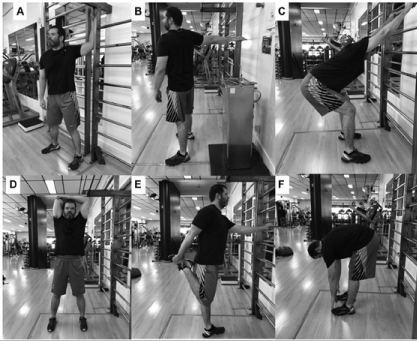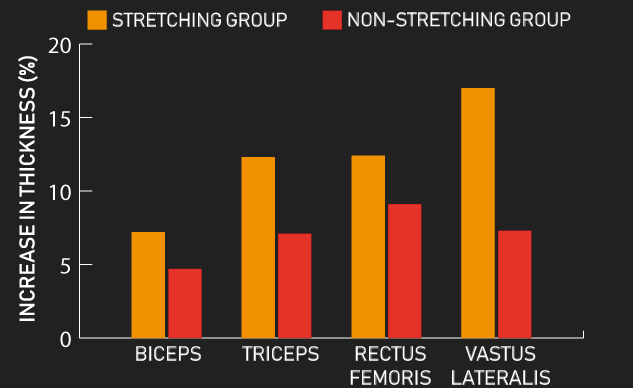
We’ve previously discussed whether flexing between sets could help build more muscle, concluding that overall, it did not seem to enhance hypertrophy.
Table of Contents
The idea of performing some activity between sets to enhance muscle growth is an attractive one to many. As we’ve detailed in the complete guide to rest intervals article, the overall research appears to indicate longer rest intervals (2.5 or more minutes of rest between sets) produces greater hypertrophy than shorter rest intervals (1 minute or less) with compound exercises at least.
Given most sets are far shorter in duration than longer rest intervals, most of your times in a gym would actually be spent resting. In this article, we’ll explore if stretching between sets could help increase muscle hypertrophy and strength gains.
Stretching in between sets isn’t a new idea. Legendary bodybuilder Frank Zane states he used to stretch the primary muscle group worked in an exercise for 15 seconds between sets.
But what does the current research say on stretching in between sets, can increase a workout’s effectiveness?
Inter Set Stretching: The Research
This study by Evangelista et al. aimed to determine just this.
Protocol:
They had 29 untrained men assigned to either a stretching group or a non-stretching group.
Both groups trained the same exercises: bench press, seated row, seated dip machine, biceps curl, leg extensions, and leg curl, each for 4 sets of 8-12 reps (each set taken to failure), twice per week for 8 weeks.
The non-stretching group rested 90 seconds between sets.
The stretching group also rested 90 seconds between sets. But during 30 of those seconds, they held a static stretch. All stretches were performed with the maximal range of motion participants could achieve pain-free.

Between sets of the bench press, they performed a stretch for the chest and anterior deltoids (image A).
Between sets of the seated row, they performed a stretch for the latissimus dorsi (image C).
Between sets of the seated dip machine, they performed a stretch for the triceps (image D).
Between sets of the biceps curl, they performed a stretch for the biceps (image B).
Between sets of the leg extension, they performed a stretch for the quadriceps (image E).
Between sets of the leg curl, they performed a stretch for the hamstrings (image F).
Measurements:
The researchers measured one-rep max on the bench press and leg extension before and after the 8 weeks for both groups.
Additionally, they also measured the thickness of the elbow flexors (which included the biceps brachii and brachialis), triceps brachii, rectus femoris, and vastus lateralis before and after the 8 weeks for both groups.
Results:
Both groups experienced similar increases in bench press one-rep max and leg extension one-rep max.
For muscle thickness, although there were no statistically significant differences in elbow flexor, triceps, and rectus femoris thickness between both groups, it is evident that the results do slightly favor the stretching group. A longer study or more participants could result in these differences being significant.

For vastus lateralis thickness, the stretching group did experience statistically significant greater increases compared to the non-stretching group.
Discussion
Interestingly, overall, this study does suggest that stretching between sets may indeed enhance hypertrophy. But, strength gains did not benefit from stretching in between sets.
The reasons as to why stretching in between sets can help build more muscle are not clear.
One potential idea is that stretching just creates more per session tension. When you stretch, passive tension is produced by various elements in your muscle (such as the extracellular matrix and a molecule called titin). This additional tension may stimulate more hypertrophy.
But again, this is just speculative, future research would be needed to explore this.
Although this study does suggest stretching in between sets may indeed enhance muscle growth, it’s important to consider the context of the study when interpreting these results.
The participants in this study were untrained. Training responses do differ between trained and untrained individuals. Therefore it’s not clear whether the results of this study would apply to trained individuals.
The participants also held the stretches with the maximum range of motion they could achieve pain-free. This is probably a noteworthy point, as previous research has suggested that holding intense stretches (that cause discomfort) before a training session reduces muscle growth.
Although this was stretching before training, it’s very possible that performing intense stretching in between sets could reduce muscle growth too.
Furthermore, the participants held the stretches for 30 seconds. There is some evidence that holding stretches for longer than this may be counterproductive.
For instance, Siatras et al. found that stretching the quadriceps for 60 seconds resulted in greater decreases in quadriceps force output compared to stretching 30 seconds. This more pronounced force loss with 60 seconds of stretching could mean the quadriceps receive less of a hypertrophic stimulus. Although, future research would be needed to validate this idea.
Lastly, at this current moment, this is the only research paper to have assessed the effects of stretching in between sets on muscle hypertrophy. Further research would most definitely be required to get a better idea if stretching between sets does truly help build more muscle.
Before moving on, if you’re curious about creating an effective training program for muscle hypertrophy, our high quality partner Alpha Progression can help. It can generate a highly effective program for you, track your workouts live with in-built progression recommendations, provide graphs displaying your long term progress, and it has a massive exercise database with more than 550 exercises.
Click HERE (the link opens in a new tab) to get a free 2 week trial of the apps features. If you like it and go beyond, the link also gives you 20% off a subscription!
We never promote trash at the House of Hypertrophy, so rest assured the app is high quality. The reviews speak to this, 4.8 starts (based on more than 7,000 reviews) on Google play, and 4.9 stars in Apple’s store (based on nearly 400 ratings).
The Unpublished Study
Now, I did actually come across information about an unpublished paper by Silva et al., exploring the effects of stretching between sets on muscle growth.
It was only presented in abstract format at a sports science conference. The abstract can be located here.
Here is what’s known about the study:
24 trained individuals were assigned to either an interset stretch group or non-stretch group.
Both groups performed 4 sets of 8-12 reps of leg press calf raises twice per week for 5 weeks.
The subjects in the interset group maintained the load on the leg press machine and held the ankle in a dorsiflexed position (stretching the calves) for 30 seconds during the rest intervals between sets.
The subjects in the non-stretch group rested normally.
What the researchers found was that the group that held overloaded stretches between sets (interset group) experienced significantly greater hypertrophy compared to the non-stretch group.
Although this study sound extremely interesting, especially because it was conducted on trained individuals, as mentioned, it was only presented at a sports science conference and the full study has since not been published. So, we can only take these results with a grain of salt at most.
Inter Set Stretching & Strength: Additional Research
I thought I’d discuss the potential impacts of stretching in between sets on strength a little more here.
As already mentioned, the study overviewed in this article did not find any beneficial effects of stretching in between sets on one-rep max bench presses or leg presses.
This could be interpreted as somewhat positive for individuals who care equally about strength and hypertrophy, as stretching may enhance muscle growth, but it will not compromise strength adaptations.
However, unlike the current research on stretching in between sets and muscle growth, there is one other paper evaluating how stretching in between sets impacts strength.
This is a paper by Souza et al.
Protocol:
They had 16 trained men assigned to a stretching group or non-stretching group.
Both groups trained the bench press, leg extension, seated row, leg curl, shoulder press, and leg press each for 4 sets of 8 reps, three times per week for 8 weeks.
The non-stretching group rested for 2 minutes between sets. The stretching group also rested 2 minutes between sets, but 30 seconds was dedicated to stretching the primary muscle group worked in the exercise they were doing.
Measurements:
The researchers assessed a 8 rep-max on all six of the exercises they performed in their training sessions before and after the 10 weeks for both groups.
Results:
What the researchers found was that both groups experienced similar strength gains for all exercises.
Therefore, this study is in agreement with the already mentioned Evangelista et al. study.
I should also mention a different paper by Borges et al.
They did not have participants stretch in between sets, but they did have one group stretching right before their working sets.
Interestingly, doing this seemed to result in overall less strength gains.
This could just be because they stretched before their sets as opposed to in between their sets, or this may imply that stretching close to a set may be counterproductive for strength.
But regardless, the current evidence seems to suggest that stretching in between sets at the very least does not help build more strength.
Conclusions
- There is direct evidence that stretching in between sets can help build more muscle, albeit for untrained individuals. But regardless of your training experience, you may wish to experiment with stretching in between sets and see how it works out for you.
- If you do wish to experiment with it, it’s probably sensible to stretch for no more than 30 seconds. Moreover, ensure that the stretch is not painful.
- If your goal is to maximize strength only, the current evidence suggests that at the very least, there is no benefit to stretching in between sets, so it’s probably best to just rest passively between sets.
Remember to feel free to check out the Alpha Progression App if you’re interested. Also feel free to check out our free bench press e-book below.

